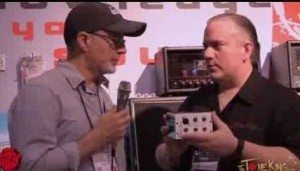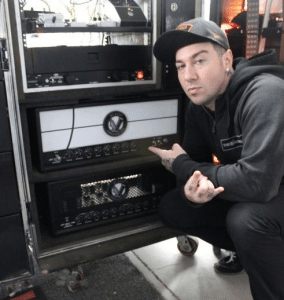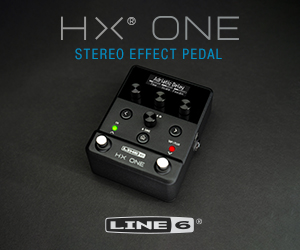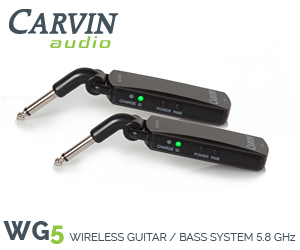Still Ascending: Jet City Amplification Plots a Course for Long-Term Success
trushack | Mar 15, 2015 | Comments 6
 Nearly five years ago, Jet City’s Douglas White called a guy in New Jersey he had never met. That phone call resulted in this review.
Nearly five years ago, Jet City’s Douglas White called a guy in New Jersey he had never met. That phone call resulted in this review.
“The very first Jet City amp, I sent to [The Tone King],” White recalls.
“I said ‘How would you like a worldwide exclusive? You can be the only guy to demo something that nobody has seen before.'” said White. “That was the start of our relationship.”
Since then, Jet City has figured prominently in many videos and features on TheToneKing.com and our readers have been treated to an inside look at a unique brand that has consistently delivered a high level of performance and value to the market. And while Jet City has gone through some behind-the-scenes changes recently, the trend they established back in 2009 and 2010 shows no signs of slowing. Jet City amps have already made the backlines of celebrated artists like Avenged Sevenfold, Job For A Cowboy, Joe Perry, the Dropkick Murphys, and Brian Nutter (Keith Urban) and are now positioned to add to an already impressive repertoire of products. And the man leading the charge is the one who was there from day one: Douglas White.
White is no stranger to the ever-changing environment of the gear market. White has been in the game since the early 2000s and has worked with other companies on amplifier production. You may even own a non-Jet City amp that White played a part in helping launch. In fact, if you’re a close follower of TheToneKing.com we KNOW you own some of his other creations! He’s exactly the type of guy you want at the helm of a small business: a creative and dedicated leader who knows how to turn ideas into reality. In the real world, especially the gear world, that’s not an easy thing to do.
 Since then, Jet City has figured prominently in many videos and features on TheToneKing.The Jet City story began in 2009, when White and renowned amp builder Mike Soldano partnered up to launch the brand. Following a year of intensive preparation, Jet City stormed into the marketplace with a straightforward plan to get its amps into the rigs of the people. That plan was to sell directly to major retailers. Among the retailers to first bring Jet City products to the street were Musician’s Friend and Musikhaus Thomann, based in Germany.
Since then, Jet City has figured prominently in many videos and features on TheToneKing.The Jet City story began in 2009, when White and renowned amp builder Mike Soldano partnered up to launch the brand. Following a year of intensive preparation, Jet City stormed into the marketplace with a straightforward plan to get its amps into the rigs of the people. That plan was to sell directly to major retailers. Among the retailers to first bring Jet City products to the street were Musician’s Friend and Musikhaus Thomann, based in Germany.
The strategy paid off almost immediately. Jet City amps were favorably reviewed in the pages of Guitar World and Guitar Player and buzz around the brand became the talk of the guitar-based internet. Sales were strong, Jet City and the retailers were enjoying solid returns, and musicians were loving what Jet City was putting out in terms of build quality, tone, and value.
Allow me brief a moment to don my Captain Obvious mask and cape: It’s really tough to run a small business, and even harder to make it successful. And businesses of any size not only have to contend with delivering what the market wants, they have to continually assess how they deliver it.
After a little bit of time, Jet City decided to add distributors into the mix. Adding distribution would help Jet City reach more retailers, but it also meant that Jet City would no longer sell direct to retailers, as it had done when it started out. It also meant another layer in the supply chain, which ended up resulting in higher prices. Through the new distribution arrangement, retailers had to pay more for Jet City products, which led to a corresponding rise in the street prices musicians would pay for Jet City products. Sales began to slow, and Jet City’s corporate leadership underwent changes. White used those changes as an opportunity to recalibrate and recapture Jet City’s early momentum.
“We were under an agreement with our U.S. distributor and we weren’t yet through with that two-year period,” White told TheToneKing.com in a recent phone call. “Both parties were  putting an effort into building the brand, but, sales never came back to the numbers we were achieving in the retail-direct model.
putting an effort into building the brand, but, sales never came back to the numbers we were achieving in the retail-direct model.
“But, at the same time, I started begging Thomann in Germany to take us back to the direct relationship. Once we reconnected, the numbers just turned right back around. Sales just took off and suddenly we’re doing way more business in Europe than we are in the United States. It totally proved to me that the original plan was the best plan.” Jet City had achieved a return to affordability, and musicians were happy to welcome them back.
“I worked through the agreement with the distributor in the U.S., and at the end of that I went back to Musicians Friend and asked them to buy the product on directly again, and they did. Halfway through last year, they started buying product directly from [Jet City], and the same thing happened. Sales just increased dramatically. We did more business with [Musicians Friend] than we did with a distributor and multiple dealers.”
This strategy is clearly well-suited to the Jet City brand, but it’s not without some second-order quirks. One observation that raised some speculation was the lack of a Jet City booth at the NAMM 2015. Every guitar slinger wandering the floor was hoping for another shot at taking Jetty Betty out for a chocolate malt, but she was nowhere to be found! White was happy to explain this to TheToneKing.com.
“I have several customers around the world and I met with all of them at NAMM,” White said. Having a booth would have little to no practical value for Jet City because of it’s direct-to-selected-retailer model, and lack of a booth helps preserve company resources that can be put into new product development. Jet City did the same thing that every company does at a NAMM showcase; it connected with retailers. The difference was that Jet City was able to do it without a booth presence.
The departure of Mike Soldano from Jet City and his recent work with Diamond Amplification also had people talking, but has a very simple explanation as well.
“Mike has done collaborative things since forever. He’s an in-demand designer, and it’s another that he did,” said White of the new amplifier that Soldano collaborated with Diamond on. As far as departing Jet City, Soldano made a decision to focus on his namesake line after some turnover in that company.
“It was quite amicable,” White said. “He called me up on the phone and said, ‘I need to divest myself of [Jet City] and focus on my Soldano business.”
With all those items now addressed, the focus of the Jet City discussion should be the interesting things that are on the horizon for the brand. White, as we’ve already discussed, is a deft operative in the gear industry. He is now the sole occupant of the captain’s chair at Jet City and has a wealth of options at his disposal for future projects. Guitar players can expect to see new collaborations and designs alongside products that have established themselves as modern classics, capable of covering a range of stylistic ground. These include the 20H and 22H heads, the flagship 100HDM 100-watt head, the killer Vintage 20HV (this author’s personal fave), effects like the Afterburner overdrive and Flood delay, and Jet City’s very own Amp Factory custom shop.
TheToneKing.com is especially proud to have been associated with Jet City for so long, and thankful that Douglas White rolled the dice and offered TheToneKing.com an amazing opportunity to provide an early product review. We’re just as excited as anybody to see what Jet City has cooking. This is an exciting time for the Jet City Amplification.
Tiny URL for this post:
Filed Under: Featured • Commentary / Editorials
About the Author:




















